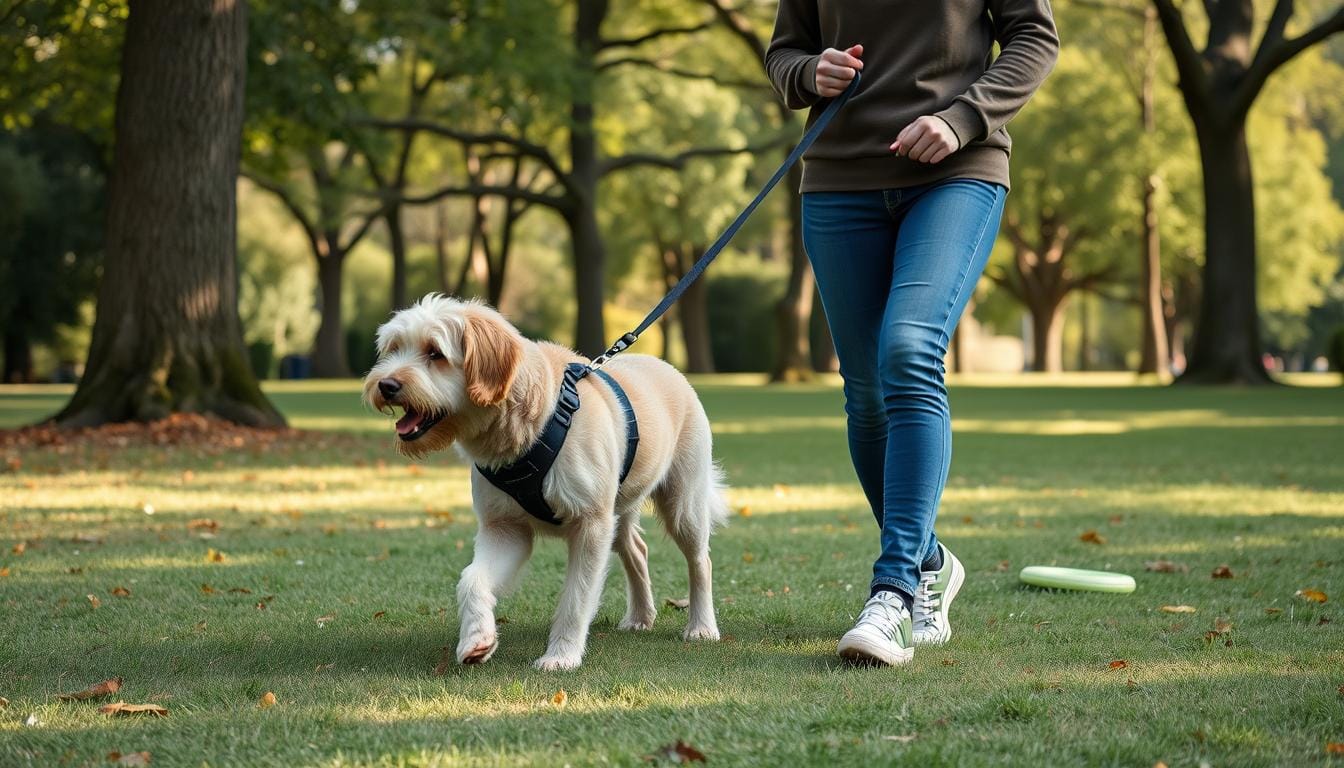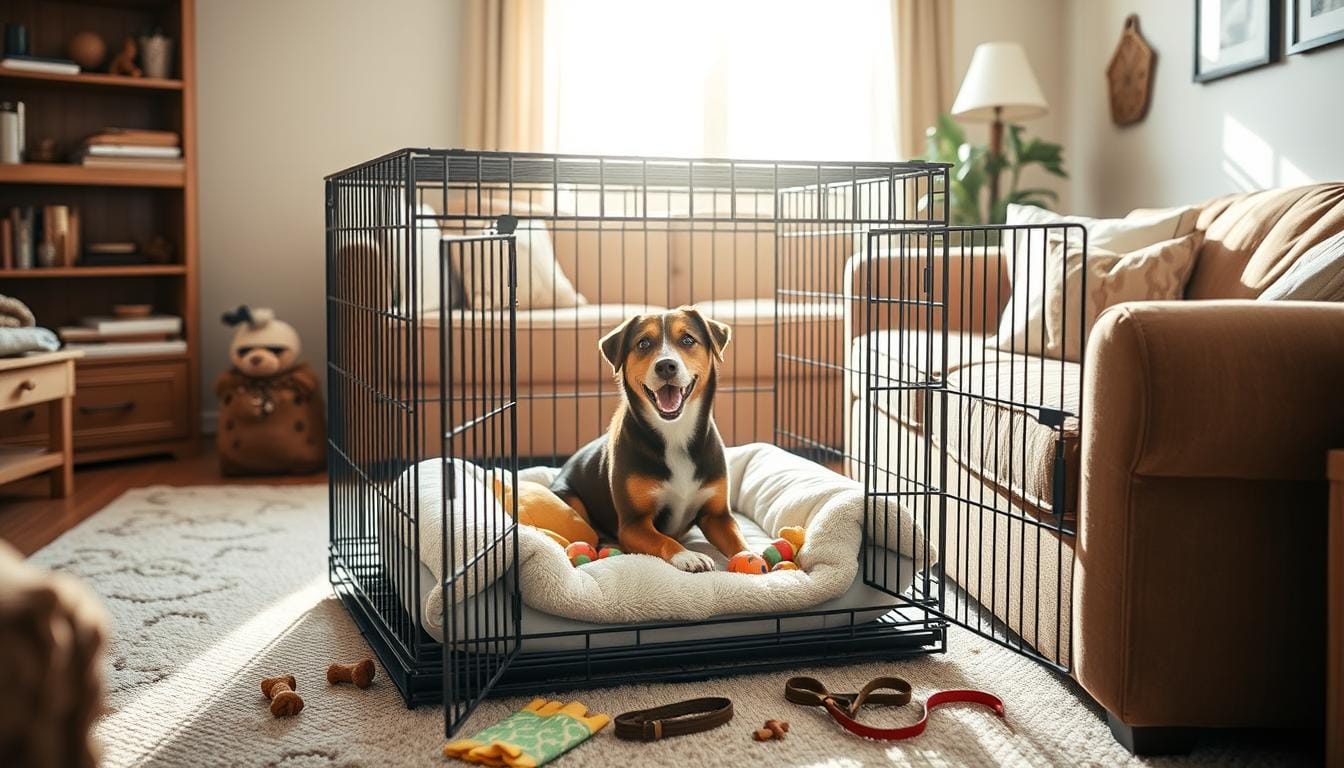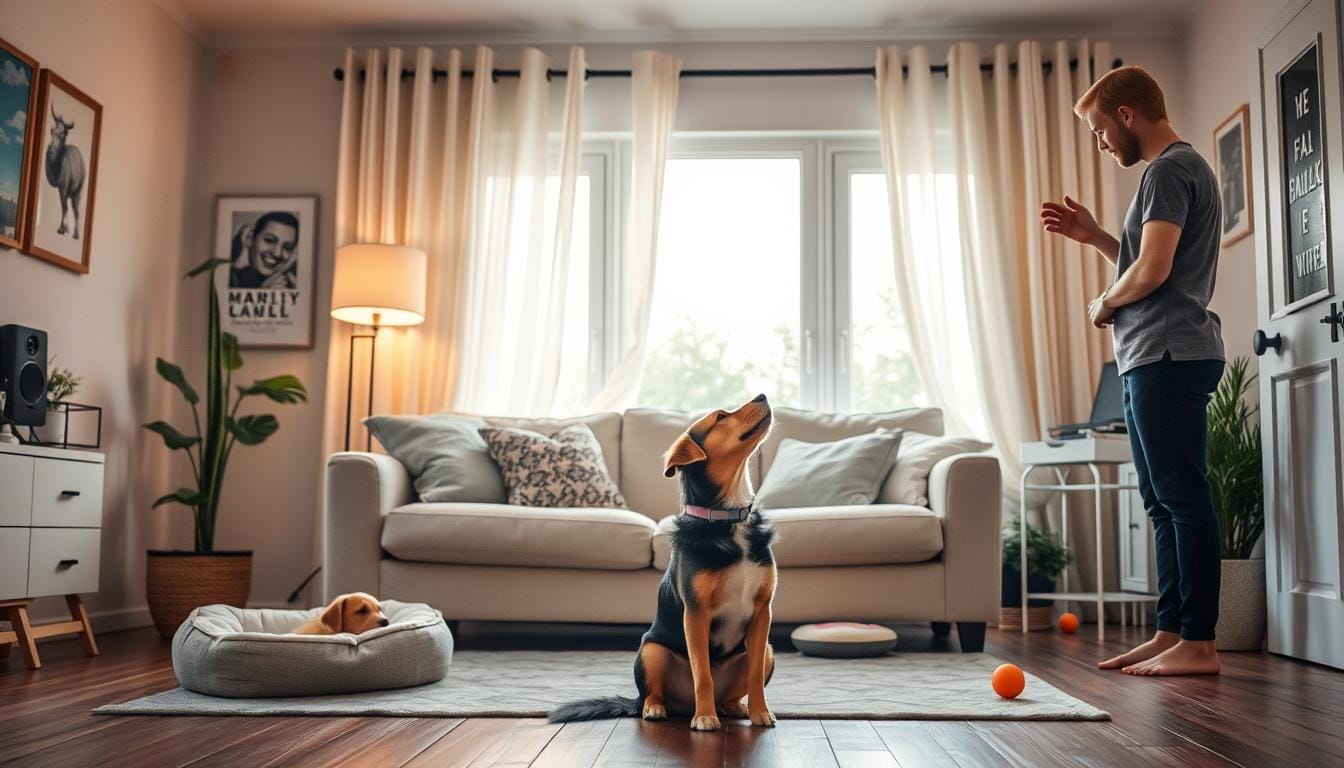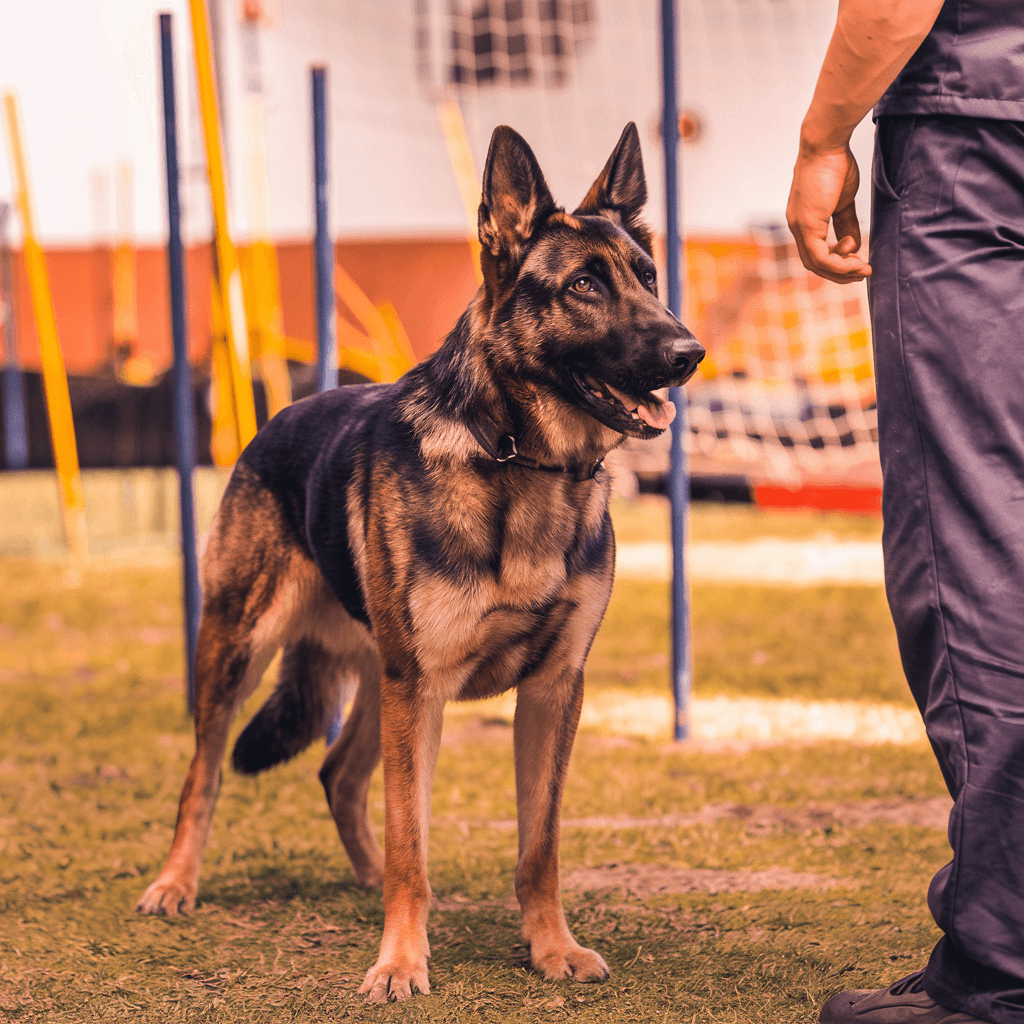Dogs can sense human emotions instinctively. They can read our facial expressions and body language. They even detect changes in our scent.
This emotional intelligence helps them communicate with us. It fosters a deep bond between humans and their furry friends.
Crate training is key in nurturing this bond. A dog crate is like a den in the wild. It provides a safe haven for your pet.
Let’s explore how crate training can strengthen your relationship with your dog. It can create a harmonious living environment.
Crate training is a journey that requires patience and understanding. It’s not just about confining your dog. It’s about creating a positive association with their personal space.
This process can take days to weeks. It depends on your dog’s unique personality and past experiences.
We’ll guide you through the essential steps of crate training. From choosing the right crate to addressing common challenges. By the end of this guide, you’ll know how to make crate training rewarding for both you and your dog.
Key Takeaways
- Crate training creates a safe space for dogs
- The process can take days to weeks
- Positive reinforcement is crucial for success
- Crates should never be used as punishment
- Proper sizing is important for comfort
- Gradual introduction yields the best results
- Consistency is key in crate training
Understanding the Importance of Crate Training
Crate training is key in shaping good dog behavior. It has many benefits for pets and their owners. Let’s see why it’s important and how it helps dogs behave well.
Benefits for Dogs and Owners
Crate training gives dogs a structured space. It helps puppies with housebreaking by strengthening their muscles. Senior dogs find a cozy spot to rest, easing joint pain and stopping them from wandering at night. It also keeps dogs safe and makes traveling easier for them.
Creating a Safe Space for Your Pet
A crate is a safe haven for dogs, like their natural dens. It’s especially good for rescue dogs who may have had a tough past. The crate offers comfort, security, and a sense of home. Make sure the crate is the right size, so your dog can move around comfortably.
Facilitating House Training and Travel
Crate training quickly teaches dogs good habits. It helps with house training by teaching puppies to hold their bladders. For travel, crates keep dogs safe in cars and are needed for flying. This training also helps dogs behave better during meals or when guests arrive.
“Crate training is the foundation for a well-behaved dog. It provides structure, safety, and comfort, benefiting both the pet and the owner.”
| Crate Training Benefits | Impact |
|---|---|
| Housebreaking | Faster and more effective |
| Emergency Preparedness | Increased safety and reduced stress |
| Travel | Easier and safer transportation |
| Behavior Management | Reduced problem behaviors |
Selecting the Right Dog Crate
Finding the perfect crate for your dog is key for good training. We’ll cover different crate types, sizes, and materials. This will help you choose wisely.
Start with size. Measure your dog’s height from head to feet and add 2 inches. For length, measure from nose to tail and add 3-4 inches. This size lets your dog stand, turn, and lie down easily.

- Wire crates: Durable, well-ventilated, and easy to clean
- Plastic crates: Great for indoor use and travel
- Wooden crates: Stylish and blend with home decor
- Soft-sided crates: Lightweight and portable, ideal for small breeds
Think about your dog’s chewing and travel needs when picking a material. For growing puppies, an expandable crate with a divider is a good choice.
“The right crate size and material can make all the difference in your dog’s comfort and security.”
| Crate Type | Best For | Features |
|---|---|---|
| Wire | Most dogs, including puppies | Sturdy, good air circulation |
| Plastic | Indoor use, travel | Easy to clean, good ventilation |
| Wooden | Home decor-conscious owners | Aesthetically pleasing, furniture-like |
| Soft-sided | Small breeds, travel | Lightweight, easy assembly |
The crate should be a safe space for your dog. Make sure it’s well-ventilated and add a cozy, washable bed. Choosing the right crate helps with training and keeps your dog happy!
Introducing Your Dog to the Crate
Introducing your dog to the crate is a key part of dog training. We’ll show you how to make your dog feel at home in their new space. It’s all about positive reinforcement and going slow.
Making Positive Associations
Begin by placing the crate in a family area. Add cozy bedding to make it inviting. This turns the crate into a safe haven for your pet. Make sure the crate is the right size for your dog.
Using Treats and Toys
Treats and toys are great for crate training. Put their favorite things inside to encourage them to explore. You can even feed them in the crate to make it a positive experience. This approach helps make the crate a happy place for your dog, as explained in this article.
Gradual Exposure Techniques
Patience is essential in crate training. Start with short times and gradually increase the crate time. Here’s a simple guide:
- Begin with 5-10 minutes while you’re home
- Slowly increase to 30 minutes
- Progress to longer periods as your dog gets comfortable
Never force your dog into the crate. Use a command like “kennel up” and reward them for going in. This makes the crate a positive space for them.
“Crate training took about two weeks for our puppy. Now he loves his little den!” – Sarah, dog owner
Remember, crate training time varies. It could take days or weeks, depending on your dog’s age and personality. Stay consistent, patient, and always keep it positive!
Establishing a Crate Training Routine

Creating a consistent crate training schedule is key to success. Start with short times and increase gradually. This helps your dog like their crate.
A good dog routine includes regular meals, exercise, and crate time. Make sure to meet your pet’s needs before crate time. This keeps them calm and relaxed in their crate.
Consistent training is crucial for a positive crate experience. Use the crate when you’re home to prevent isolation feelings. Keep arrivals and departures calm to avoid anxiety.
| Age | Daytime Crating | Nighttime Crating |
|---|---|---|
| 8-10 weeks | 30-60 minutes | 6-7 hours |
| 11-14 weeks | 1-3 hours | 7-8 hours |
| 15-16 weeks | 3-4 hours | 8-9 hours |
| 17+ weeks | 4-5 hours | 9+ hours |
The American Kennel Club says a crate training schedule is best for housebreaking puppies. Our sample schedule shows crate use for day and night based on age.
Consistency in crate training routines helps dogs not only accept being crated but also become enthusiastic about using the crate for various activities.
Remember, patience and persistence are vital in creating a successful crate training routine. With time and effort, your dog will view their crate as a safe and comfortable space.
Feeding Time and the Crate
Crate feeding is a great tool in dog training. It makes the crate a cozy spot for your dog. Let’s look at ways to make meal times and crate time positive for your dog.
Meal-Time Crating Strategies
Begin by putting your dog’s food bowl near the crate. Slowly move it closer until it’s inside. This makes the crate a place of joy for your dog, tied to their meals!
Once they’re okay with eating inside, close the door during meals. This training method speeds up crate training a lot.
Building Positive Associations with Food
Give special treats or use food-dispensing toys to make crate time fun. This links the crate to tasty rewards. The goal is to make the crate a happy place, not a punishment.
Extending Post-Meal Crate Time
After eating, keep your dog in the crate for a bit. Start with a few minutes and increase it over time. This helps your dog get used to being in the crate without food.
It’s a key step in building their confidence in the crate.
| Age Group | Max Crate Time | Training Duration |
|---|---|---|
| Puppies (<6 months) | 3-4 hours | Days to weeks |
| Adult Dogs | 8-10 hours | 1-2 weeks |
| Senior Dogs | 6-8 hours | 2-4 weeks |
Remember, patience is crucial in crate training. Every dog learns at their own pace. Adjust your training to fit your dog’s needs and personality.
Extending Crate Time and Building Confidence
Increasing crate time is key in your dog’s training. We start with short periods, like 5-10 minutes. Then, we work up to 30 minutes or more. This helps build your dog’s confidence and makes them see the crate as a good place.
To make crate time fun, we use puzzle toys or frozen treats. These keep your dog busy and show them the crate is a fun spot. We also practice leaving the room for a bit, then coming back before they get anxious. This makes your pet feel safe even when you’re not there.
It’s important to reward calm behavior in the crate. When your dog stays calm, give them praise or a small treat. This positive feedback helps them want to stay calm again and boosts their confidence. But, don’t make a big deal when letting them out to avoid over-excitement.
- Start with 5-10 minute sessions
- Use engaging toys and treats
- Practice short absences
- Reward calm behavior
- Gradually increase duration over weeks or months
Getting to longer crate times takes time. We suggest increasing crate time over weeks or months, based on your dog’s progress. This slow approach makes the experience stress-free and helps your dog feel confident in their crate.
Nighttime Crating and Sleep Training
Nighttime crating and sleep training are key for your dog’s growth. We’ll show you how to set up successful nights, handle whining, and help your dog sleep through the night.
Setting Up for Successful Nights
Begin by putting the crate in your bedroom. This lets you hear if your dog needs to go outside. Create a bedtime routine, including a last potty trip before bed. Also, feed your puppy’s last meal 3-4 hours before bed to help with digestion and reduce bathroom needs at night.
Addressing Nighttime Whining
Puppies may cry at first when crate training. It’s vital to tell the difference between distress and demand barking. Distress barking is loud and non-stop, while demand barking is repetitive and sounds like they’re asking for something. Ignore the whining unless you’re sure your dog needs to go outside.
Gradual Transition to Full Nights
For puppies under 4-5 months, use alarms for nighttime potty breaks. This helps prevent accidents and stops demand barking. As your puppy grows, you can slowly increase the time between breaks. With patience and consistency, most dogs get used to nighttime crating in a few weeks or months.
| Age | Approximate Nighttime Potty Break Frequency |
|---|---|
| 8-10 weeks | Every 2-3 hours |
| 11-14 weeks | Every 3-4 hours |
| 15-16 weeks | Every 4-5 hours |
| 17+ weeks | Every 5-6 hours or through the night |
Troubleshooting Common Crate Training Challenges
Crate training can sometimes be tough. Whining and anxiety are common problems pet owners face. To stop demand barking, ignore it unless your dog needs to go outside.
For anxious dogs, start with shorter crate times and gradually increase. This helps them adjust better.
Dealing with aggression or protest barking in the crate needs a new approach. Never use the crate as punishment. Make it cozy with a comfy bed and familiar smells.
For puppies, a puppy pen with bedding and an open crate door can help. This makes them feel more at ease.
If your dog soils the crate, don’t leave them in it too long. Clean it well to remove any smells. Puppies might need to go outside every 15-20 minutes at 2-3 months old.
If problems persist or your dog is very anxious, get help from a professional dog trainer or behaviorist. With patience and understanding, we can make crate training positive for our pets.
















